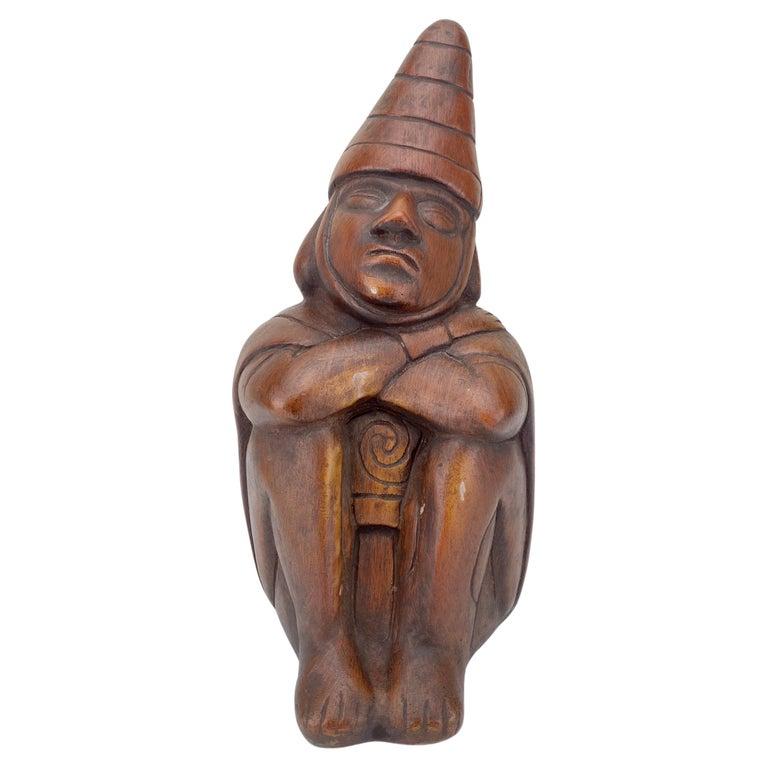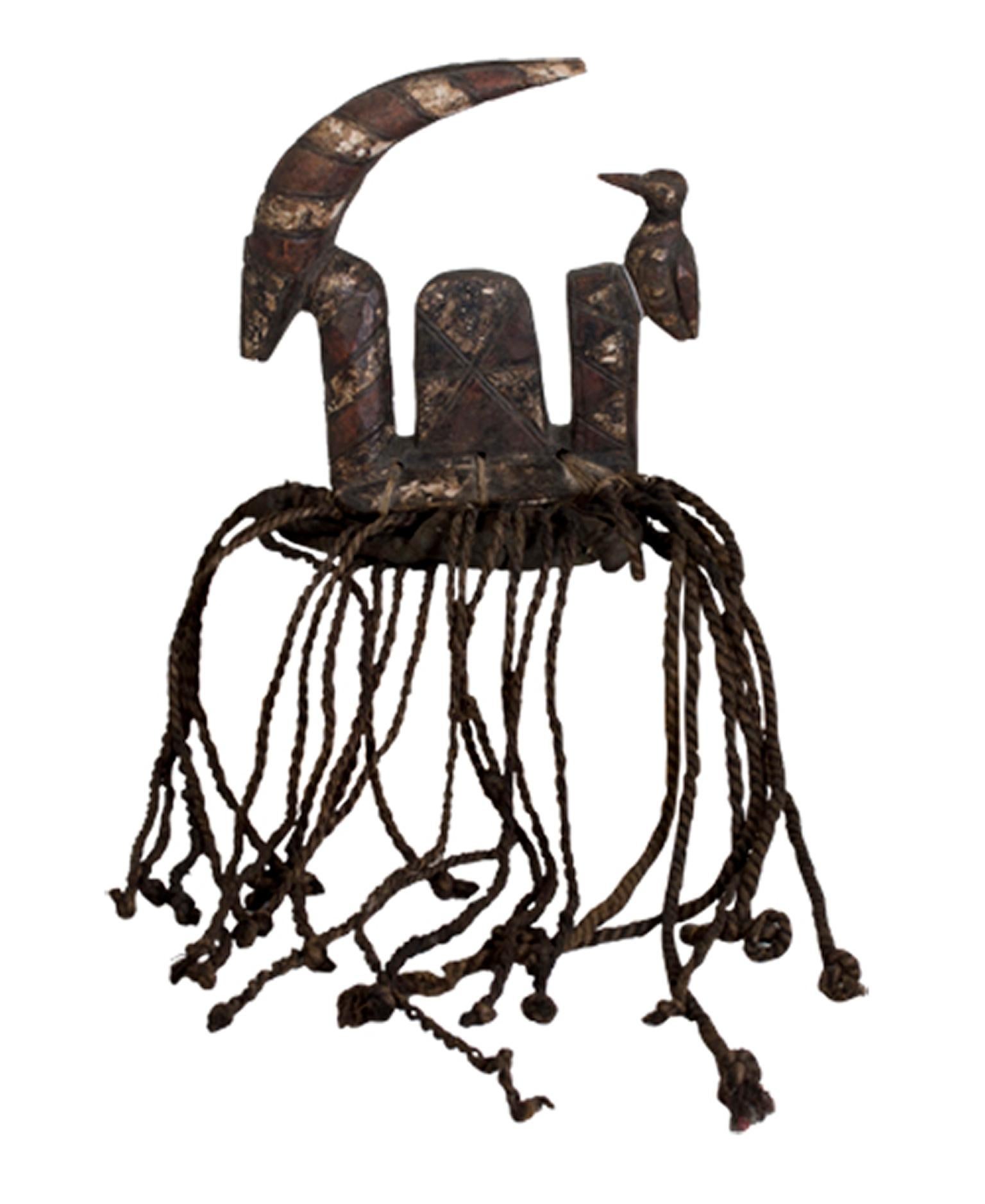Items Similar to "Fertility" African Wood Sculpture by the Lobi People
Video Loading
Want more images or videos?
Request additional images or videos from the seller
1 of 13
Unknown"Fertility" African Wood Sculpture by the Lobi PeopleUnknown
Unknown
About the Item
Carved wood figure by West African Lobi People.
"The Lobi People live in a vast geographical area that stretches from Burkina Fasso, to the Ivory Coast and into Ghana. Lobi bateba figures have a wide degree of style and are made for a wide range of purposes. In Lobi communities anyone can learn to carve, it is not limited to people with specialized training. Lobi bateba figures are believed to be able to act in behalf of their owner, they are considered a living being and have the ability to act out against forces that could harm it’s owner or bring good things to it’s owner depending on it’s intended purpose." This statue was made to ensure a successful birth.
- Creation Year:Unknown
- Dimensions:Height: 37 in (93.98 cm)Width: 7 in (17.78 cm)Depth: 6.5 in (16.51 cm)
- Medium:
- Movement & Style:
- Period:
- Condition:Good. Minor loss on the base.
- Gallery Location:Pasadena, CA
- Reference Number:1stDibs: LU65438293032
About the Seller
5.0
Vetted Seller
These experienced sellers undergo a comprehensive evaluation by our team of in-house experts.
Established in 1999
1stDibs seller since 2017
51 sales on 1stDibs
Typical response time: 16 hours
- ShippingRetrieving quote...Ships From: Pasadena, CA
- Return PolicyThis item cannot be returned.
More From This SellerView All
- Brutalist Wood SculptureLocated in Pasadena, CAFrom the primal landscapes of our world grow the materials that fuel our creativity - a phenomenon echoed in the creation of this brutalist sculpture. We stand with an art piece who...Category
Late 20th Century Constructivist Figurative Sculptures
MaterialsWalnut
- "Doubles" Large Wall Sculpture by Craig FrenchLocated in Pasadena, CACraig French is a contemporary pop-Constructivist sculptor, whose brilliant, lyrical wall pieces have gained an international audience. Cast resins, acryl...Category
Early 2000s Constructivist Abstract Sculptures
MaterialsCopper, Steel
- Jerry O'Day Nude Drawing #2Located in Pasadena, CAGracious nude of a woman drawn with ink on craft paper. Jerry O'Day is also known as Geraldine Heib. Born in Oakland, CA on June 17, 1912. Geraldine Heib assumed the name Jerry O'Day at an early age. She grew up in Washington and studied in Seattle at the Cornish School of Fine Arts. Upon moving to the San Francisco Bay area in 1938, she further studied with Bufano as a muralist for two years. She wed sculptor David Lemon and had a gallery in a converted cod fishery in Belvedere from 1942 until 1963. At that time the couple moved to a houseboat in Sausalito where she remained until her demise on March 30, 1986. Exh: San Francisco Art Association, 1941; CPLH, 1962. Solo Exhibitions: City of Paris, Rotunda Gallery; Lucien Labaudt Gallery, 1963; Torrance Gallery, San Anselmo...Category
1950s Other Art Style Nude Drawings and Watercolors
MaterialsPaper, Ink, Wood
- Modern Gouache 1988 #2 by Albert RadoczyBy Albert RadoczyLocated in Pasadena, CAStylized gouache Radoczy interpretation of a woman (probably his wife who was his favorite subject. Signed A. Radoczy, March 1988. This work is part of a series of 4. On a wall toget...Category
Late 20th Century American Modern Paintings
MaterialsFabric, Wood, Paper, Lights, Gouache
- "Jupiter Four 9/10" Black & White Abstract by Lucy SiekmanLocated in Pasadena, CAAn abstract, black and white lithograph contained in an interesting shape enclosed by clean negative space. Signed L. Siekman, titled Jupiter Four and numbered 9/10. It is part of a ...Category
1980s Abstract Geometric Prints and Multiples
MaterialsPlexiglass, Wood, Paper, Lithograph
- "Young Boys" Monotype by California listed Olga HigginsLocated in Pasadena, CACasein monotype by Santa Barbara artist Olga Higgins depicting 2 young boys playing together. Hangs in its original walnut frame.Category
Mid-20th Century Other Art Style Portrait Prints
MaterialsPaper, Casein, Wood
You May Also Like
- "Idgo Nigeria Female Standing, " Wood Statue with Blue & White Pigment circa 1930Located in Milwaukee, WI"Idgo Nigeria Female Standing" is a wooden statue with blue and white pigment created in Nigeria circa 1930. This figure stands up right with arms out slightly in front of her. A st...Category
1930s Tribal Figurative Sculptures
MaterialsWood
- Peruvian Figural Wood Carved Sculpture After Moche Stirrup Vessel, DreamerLocated in Plainview, NYPeruvian Figural Wood Carved Sculpture After Moche Stirrup Vessel, Dreamer: A stirrup vessel takes on the shape of a seated man with closed eyes, animated facial features, draped ...Category
20th Century Tribal Abstract Sculptures
MaterialsWood
- The KissLocated in Troy, NYThis sculptural head is made in Haiti from mahogany wood. The wood has a worn, dark brown patina. The carving is somewhat minimalistic, thus giving a modern twist to a tribal gesture...Category
1950s Tribal Figurative Sculptures
MaterialsMahogany
- "Dan Guéré" African Tribal Art Mask Sculpture from Ivory Coast, 20th CenturyLocated in Coimbra, PTRare African art mask in carved wood from the Ivory Coast or Liberia 20th Century. This mask is carved in wood, representing female face in painted ca...Category
20th Century Tribal Figurative Sculptures
MaterialsMetal
- Kwa-Giulth ThunderbirdLocated in San Francisco, CAThis artwork titled "Kwa-Giulth, Thundrbird" 1987 is a wood carving bas-relief by Canadian artist Kevin Cranmer, b.1968 It is signed, titled and dated in...Category
Late 20th Century Tribal Figurative Sculptures
MaterialsWood
- "Mossi Head dress Mas ceremonies Rep Upper Volta, " Wood created c. 1910Located in Milwaukee, WI"Mossi Head dress Mas ceremonies Rep Upper Volta" is a wood sculpture that includes various other materials such as fabric, and fibers. An abstracted animal with a hump and a bird on it's back make up the top of the headdress. 27" x 6" x 1" The Mossi states were created about 1500 A.D., when bands of horsemen rode north from what is now northern Ghana into the basin of the Volta River and conquered several less powerful peoples, including Dogon, Lela, Nuna, and Kurumba. These were integrated into a new society call Mossi, with the invaders as chiefs and the conquered as commoners. The Mossi make both political art and spiritual art. Figures are used by the ruling class to validate political power, and masks are used by the conquered peoples to control the forces of nature. The several mask styles reflect the diversity of the population before the 15th century invasion. Long tall masks...Category
1910s Tribal Abstract Sculptures
MaterialsFabric, Wood
Recently Viewed
View AllMore Ways To Browse
Wood Sculpture Century
Wide Sculptures
Mid Century Sculpture Wood Vintage
Figure Wood Sculpture
Wood Figure And Sculpture
African Wood Art
Africa Wood Art
African Vintage Sculpture
Wood Carved People
Fertility Art
Wood Carved Figural Sculpture
African Wood Sculptures
African Wood Sculpture
Wood Sculpture Africa
Vintage Statues Art Sculptures
People Statues
Carved Wood Sculpture Statue
Tribal Fertility




